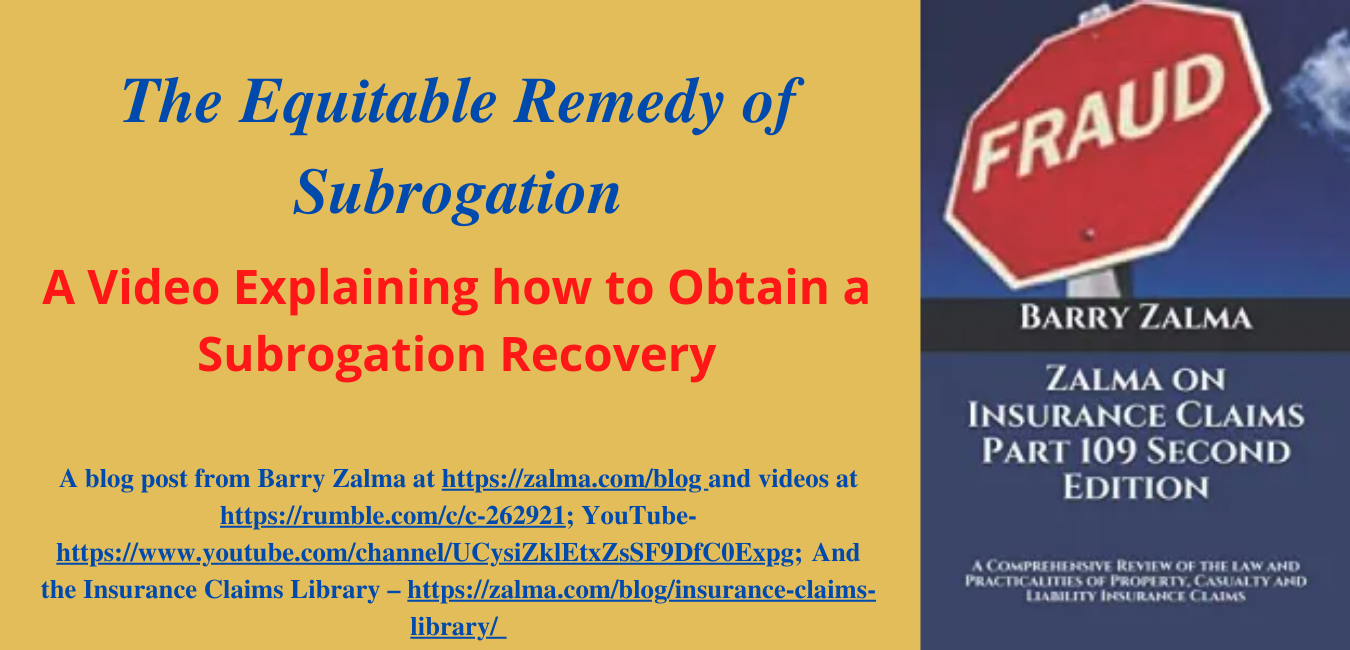-
News Feed
- EXPLORE
-
Pages
-
Groups
-
Events
-
Blogs
-
Marketplace
-
Offers
-
Jobs
-
Developers
Equitable Remedy of Subrogation

A Video Explaining how to Obtain a Subrogation Recovery
Read the full article at https://www.linkedin.com/pulse/equitable-remedy-subrogation-barry-zalma-esq-cfe and see the full video at https://www.rumble.com/zalma and at https://youtu.be/3ySaMge6o6k and at https://zalma.com/blog plus more than 3900 posts.
Equity allows creative remedies for wrongs that do not fit within the confines of traditional tort or contract remedies (i.e., with cash). The ancient maxim “for every wrong there is a remedy” (California Civil Code § 3523) applies to subrogation rights. The maxims were adopted from the common law of England and are relied on in all jurisdictions. In California, the maxims were codified in its Civil Code.
The purpose of equitable subrogation is “to prevent forfeiture and unjust enrichment.” [Eastern Savings Bank, FSB v. Pappas, 829 A.2d 953, 957 (D.C.2003)]
The roots of equitable subrogation lie in the concept of remedying a mistake. In Hicks v. Londre, 125 P.3d 452, 458 (Colo.2005) the Colorado Supreme Court observed that equitable subrogation is appropriate when mistake is involved. [Joondeph v. Hicks, 235 P.3d 303 (Colo., 2010)]
Equitable subrogation is a doctrine that allows one who has discharged the debt of another to succeed to the rights of the satisfied creditor. For example, if Creditor # 3 pays off a debt owed to Creditor # 1 by the same debtor, equitable subrogation would enable Creditor # 3 to jump ahead of Creditor # 2 in priority for repayment. The doctrine, which began in the English courts of equity as a way for a surety to seek repayment from a defaulting debtor, has been applied by the Delaware Court of Chancery for over a century. [Eastern Savings Bank, FSB v. Cach, LLC, Supreme Court of Delaware, 124 A.3d 585 (2015)]
ZALMA OPINION
Subrogation is an equitable remedy and with the assistance of a professional claims person becomes a profit center to an insurer since it can reduce or fully reimburse the insurer for monies paid to an insured. Every claims investigation must include an investigation of subrogation potential.
We are 100% funded for October.
Thanks to everyone who helped out. 🥰
Xephula monthly operating expenses for 2024 - Server: $143/month - Backup Software: $6/month - Object Storage: $6/month - SMTP Service: $10/month - Stripe Processing Fees: ~$10/month - Total: $175/month
- Art
- Causes
- Crafts
- Crime
- Dance
- Drinks
- Film
- Finance
- Fitness
- Food
- Games
- Gardening
- Health
- Home
- Literature
- Music
- Networking
- Paranormal
- Other
- Politics
- History
- News
- Party
- Science
- Religion
- Shopping
- Sports
- SyFy
- Politically Incorrect
- Philosophy
- Theater
- Technology
- Wellness



